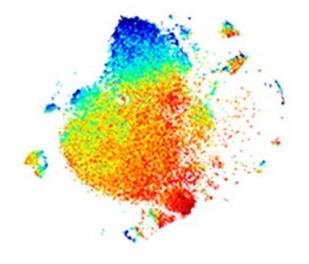Reviewed by Alex SmithApr 6 2022
Researchers at the University of Illinois Chicago recognized two subtypes of neutrophils using a protein nanoparticle they designed and discovered that one of the subtypes can be employed as a drug target for inflammatory diseases.
 Intensities of protein expression of markers are shown on viSNE map as spectrum colored dots, with low in blue, high in red. Image Credit: Bachmaier, et al., ACS Nano.
Intensities of protein expression of markers are shown on viSNE map as spectrum colored dots, with low in blue, high in red. Image Credit: Bachmaier, et al., ACS Nano.
Neutrophils are a kind of white blood cell that aid in the removal of dead cells, combat infection and heal tissue injuries. However, the role of neutrophils in individuals with chronic inflammation, such as Crohn’s disease or arthritis, or excessive inflammation, such as sepsis, may be harmful.
Neutrophils have been shown in studies to contribute to tissue damage, making inflammation a double-edged sword. Current anti-inflammatory drugs that target neutrophils, however, suppress all of their functions, which include their anti-infection and healing abilities.
The researchers from UIC were the first to characterize neutrophils into two subsets.
Understanding the differences between these neutrophil subsets opens the door for more research on treatments that address inflammatory diseases without increasing patients’ risks of infections.
Kurt Bachmaier, Study Author and Assistant Professor, Department of Pharmacology and Regenerative Medicine, College of Medicine
Kurt Bachmaier headed the study.
Bachmaier and his associates first looked at how neutrophils from blood, bone marrow, lung tissues and spleen interacted with the nanoparticle platform, which was made from a protein called albumin. They discovered that while some neutrophils carried the albumin nanoparticle into the cell via endocytosis, others did not.
The subtype that easily endocytosed the nanoparticle was dubbed ANP-high, or albumin nanoparticle high, by the researchers. ANP-low neutrophils were those that did not absorb the albumin nanoparticle.
Further research using the albumin nanoparticle revealed that the subtypes have unique cell surface receptors and are functionally distinct in terms of their beneficial ability to kill bacteria and their detrimental potential to enhance inflammation.
Neutrophils with high ANP levels did not help destroy bacteria, but they did produce excessive amounts of reactive oxygen species, inflammatory chemokines and cytokines, all of which contribute to inflammatory disease.
The researchers performed clever experiments using the albumin nanoparticle to deliver drug treatments because the ANP-high neutrophils are also the ones who captured the nanoparticle. They loaded an anti-inflammatory drug into the nanoparticle and gave it to mice suffering from sepsis. They discovered that the mice that were given the drug-loaded nanoparticle had less tissue inflammation, but their neutrophilic host defense was unaffected.
“The albumin nanoparticle, which was filled with the drug, specifically bound to ANP-high neutrophils and unloaded their cargo into the cell, stopping it in its tracks. We found ANP-high neutrophils not only in mice but also in humans, opening the possibility of neutrophil subset-specific targeted therapy for human inflammatory diseases,” Bachmaier remarks.
Science can be a bit like magic—by targeting only the ANP-high neutrophils, we stopped the out-of-control inflammation while preserving the bacteria-fighting inflammation of these Janus-like cells.
Asrar Malik, Study Senior Author, Schweppe Family Distinguished Professor and Head, Department of Pharmacology and Regenerative Medicine, College of Medicine
The study was published in the journal ACS Nano, a scientific publication of the American Chemical Society and the primary nanotechnology journal.
The co-authors of the study are Andrew Stuart, Amitabha Mukhopadhyay, Sreeparna Chakraborty, Zhigang Hong, Li Wang, Yoshikazu Tsukasaki, Mark Maienschein-Cline, Balaji Ganesh, Prasad Kanteti and Jalees Rehman.
Journal Reference:
Bachmaier, K., et al. (2022) Albumin Nanoparticle Endocytosing Subset of Neutrophils for Precision Therapeutic Targeting of Inflammatory Tissue Injury. ACS Nano. doi.org/10.1021/acsnano.1c09762.